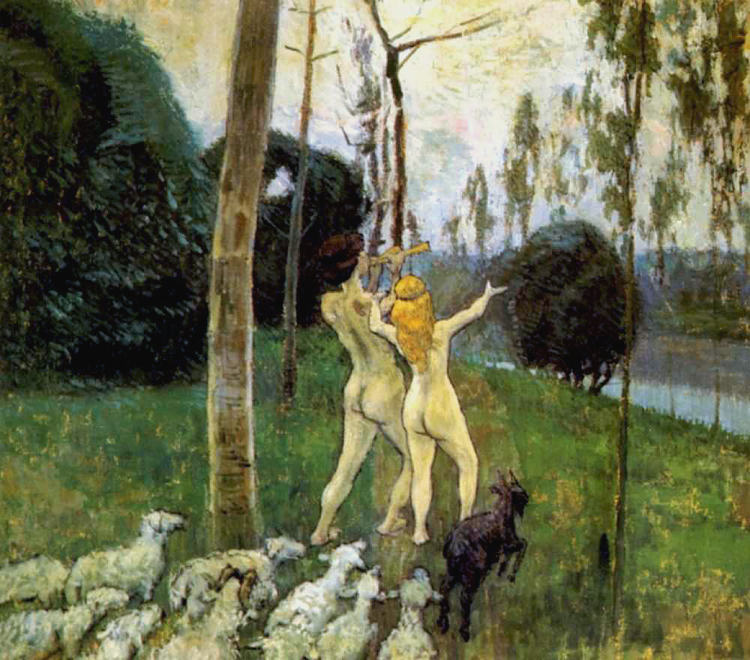 |
| François Gérard, circa 1824. |
(Freely edited and adapted from Wikipedia)
Daphnis and Chloe (Greek: Δάφνις καὶ Χλόη) is the only known work of the 2nd century AD Greek novelist Longus. Nothing is known of the author's life, or even if that was his actual name. If it indeed was, he was possibly a freedman of some Roman family which bore the name as a cognomen. The novel was given a contemporary setting on the isle of Lesbos, when and where scholars assume the author to have lived.
 |
| Daphnis et Chloé demandant à un vieux chevrier ce que c'est que l'amour, by Lancelot-Théodore, comte de Turpin de Crissé, 1809. |
It's the tale of a boy - Daphnis - and a girl - Chloe - each of whom is left abandoned - as a form of infanticide - out in the country. But a goatherd named Lamon discovers Daphnis, and a shepherd called Dryas finds Chloe. Each decides to raise the child he finds as his own. The two children grow up together, herding the flocks of their foster parents. They fall in love but, being completely naive, do not understand what to do with their feelings. Philetas, a wise old cowherd, explains to them what love is and tells them that the only cure is kissing. They do this.... Eventually, Lycaenion, a woman from the city, educates Daphnis in love-making. He decides not to test his newly acquired skill on Chloe, however, because Lycaenion tells him that Chloe "will scream and cry and lie bleeding heavily [as if murdered]." Throughout the book, Chloe is courted by suitors, two of whom - Dorcon and Lampis - attempt with varying degrees of success to abduct her. She is also carried off by raiders from a nearby city and only saved by the intervention of the god Pan. Meanwhile, Daphnis falls into a pit, gets beaten up, is abducted by pirates, and is very nearly raped. [!] In the end, the two lovers are recognized by their birth parents, get married, and live out the rest of their lives in bucolic contentment.
 |
| Konstantin Somov, 1930. |
 |
| John-Étienne Chaponnière, 1828. |
 |
| Paris Bordone, circa 1555-60. |
 |
| Set design for the Diaghilev production of Daphnis et Chloé, by Léon Bakst, 1912. |
 |
| Jehan-Georges Vibert, 1866. |
 |
| Nicolas-Andre Monsiau, 1817. |
 |
| Pedro Weingärtner, 1891. |
 |
| Joseph-Marius Ramus, 1835. |
 |
| François Boucher, 1743. |
 |
| Harold Speed, 1924. |
 |
| Pieter van der Werff, circa 1700. |
 |
| Adriaen van der Werff, circa 1694. |
 |
| Gerald Brockhurst, circa 1914. |
 |
| Louis Hersent, 1842. |
 |
| Jean-Baptiste Carpeaux, 1874. |
 |
| Dominique Papety, circa 1830s-40s. |
 |
| Idylle, by Camille-Félix Bellanger, 1893 (?). |
 |
| Pierre Cabanel, circa 1870. |
 |
| Victor Borisov-Musatov, 1901. |
 |
| L'Orage, by Pierre-Auguste Cot, 1880. |
 |
| Jean-Pierre Cortot, 1825. |
 |
| Printemps, by Jean-Francois Millet 1865. |
 |
| Maurice Denis, 1918. |
 |
| Daphnis et Chloé revenant de la montagne, by Charles Gleyre, circa 1850. |
 |
| The Wooing of Daphne, by Arthur Lemon, 1881. |
 |
| Idylle, by Jean-Léon Gérôme, 1852. |
 |
| Paysage avec Daphnis et Chloé, by François-Louis Français, circa 1897. |




No comments:
Post a Comment